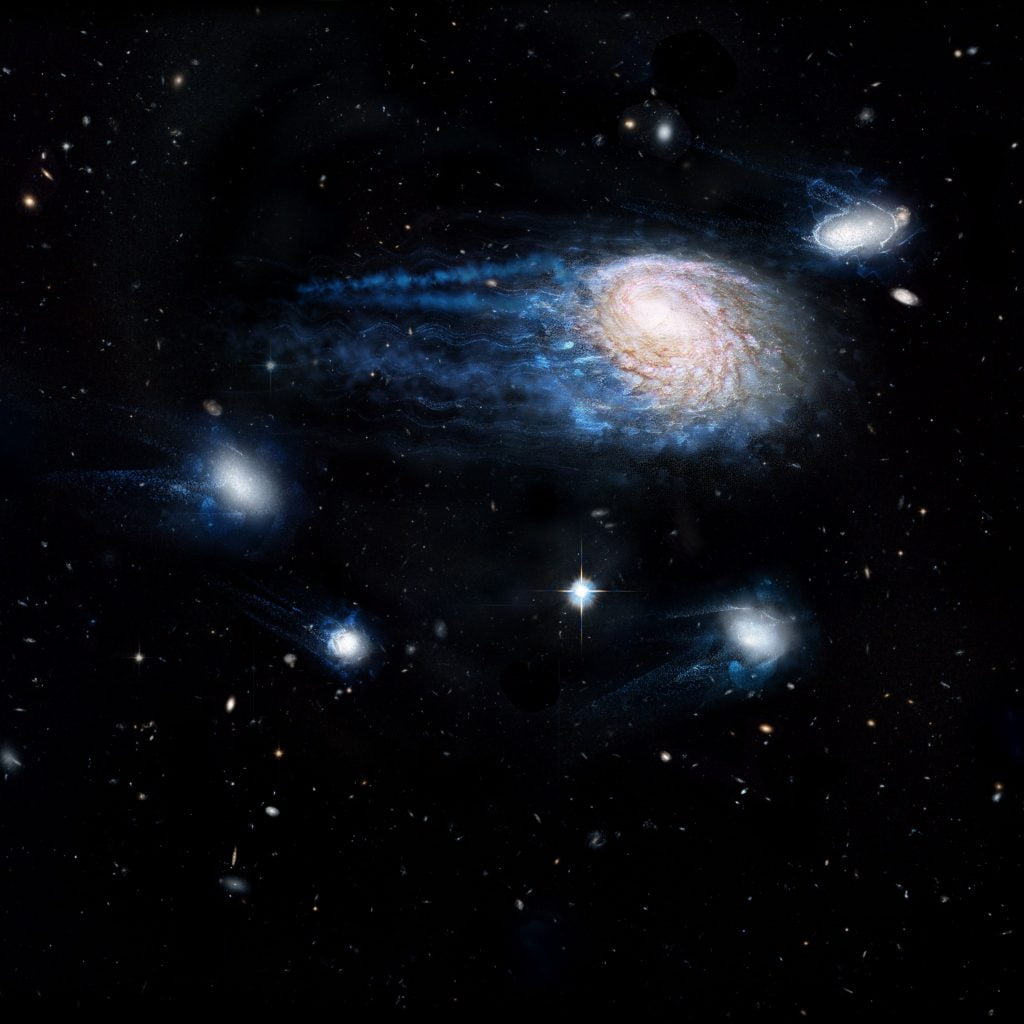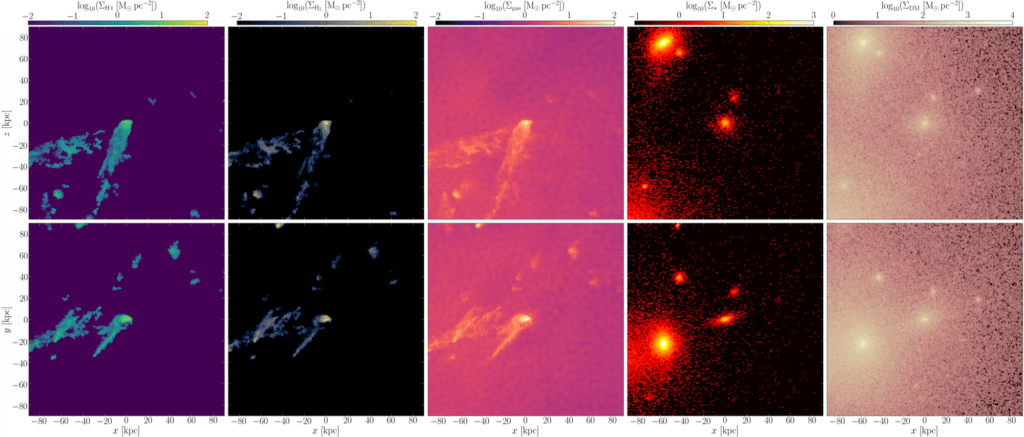
From International Centre for Radio Astronomy Research – ICRAR(AU)
February 23, 2021
Large galaxies are known to strip the gas that occupies the space between the stars of smaller satellite galaxies.
In research published today [MNRAS], astronomers have discovered that these small satellite galaxies also contain less ‘molecular’ gas at their centres.
Molecular gas is found in giant clouds in the centres of galaxies and is the building material for new stars. Large galaxies are therefore stealing the material that their smaller counterparts need to form new stars.

An artist’s impression showing the increasing effect of ram-pressure stripping in removing gas from galaxies, sending them to an early death. Credit: ICRAR(AU), NASA(US), ESA(EU), the Hubble Heritage Team (STScI(US)/AURA(US))
Lead author Dr Adam Stevens is an astrophysicist based at UWA working for the International Centre for Radio Astronomy Research (ICRAR) and affiliated to the ARC Centre of Excellence in All Sky Astrophysics in 3 Dimensions (ASTRO 3D)(AU).
Dr Stevens said the study provides new systematic evidence that small galaxies everywhere lose some of their molecular gas when they get close to a larger galaxy and its surrounding hot gas halo.
“Gas is the lifeblood of a galaxy,” he said.
“Continuing to acquire gas is how galaxies grow and form stars. Without it, galaxies stagnate.
“We’ve known for a long time that big galaxies strip ‘atomic’ gas from the outskirts of small galaxies.
“But, until now, it hadn’t been tested with molecular gas in the same detail.”
ICRAR-UWA astronomer Associate Professor Barbara Catinella said galaxies don’t typically live in isolation.
“Most galaxies have friends,” she says.
“And when a galaxy moves through the hot intergalactic medium or galaxy halo, some of the cold gas in the galaxy is stripped away.
“This fast-acting process is known as ram pressure stripping.”

Two viewing angles of a galaxy undergoing ram-pressure stripping in the IllustrisTNG simulation. Each column shows matter of a different form in the galaxy and its immediate surroundings. From left to right: (1) atomic gas; (2) molecular gas; (3) all gas; (4) stars; and (5) dark matter. Credit: Adam Stevens/ICRAR(AU).

The research was a global collaboration involving scientists from the University of Maryland(US), MPG Institute for Astronomy [MPG Institut für Astronomie](DE), U Heidelberg [Ruprecht-Karls-Universität Heidelberg](DE), Harvard-Smithsonian Center for Astrophysics(US), University of Bologna [Alma mater studiorum – Università di Bologna](IT) and Massachusetts Institute of Technology(US).
Molecular gas is very difficult to detect directly.
The research team took a state-of-the-art cosmological simulation and made direct predictions for the amount of atomic and molecular gas that should be observed by specific surveys on the Arecibo telescope in Puerto Rico and the IRAM 30-meter telescope in Spain.


They then took the actual observations from the telescopes and compared them to their original predictions.
The two were remarkably close.
Fly-through of galaxies having their gas stripped in the IllustrisTNG simulation.
Associate Professor Catinella, who led the Arecibo survey of atomic gas, says the IRAM 30-meter telescope observed the molecular gas in more than 500 galaxies.
“These are the deepest observations and largest sample of atomic and molecular gas in the local Universe,” she says.
“That’s why it was the best sample to do this analysis.”
The team’s finding fits with previous evidence that suggests satellite galaxies have lower star formation rates.
Dr Stevens said stripped gas initially goes into the space around the larger galaxy.
“That may end up eventually raining down onto the bigger galaxy, or it might end up just staying out in its surroundings,” he said.
But in most cases, the little galaxy is doomed to merge with the larger one anyway.
“Often they only survive for one to two billion years and then they’ll end up merging with the central one,” Dr Stevens said.
“So it affects how much gas they’ve got by the time they merge, which then will affect the evolution of the big system as well.
“Once galaxies get big enough, they start to rely on getting more matter from the cannibalism of smaller galaxies.”
See the full article here .
five-ways-keep-your-child-safe-school-shootings
Please help promote STEM in your local schools.
ICRAR(AU) is an equal joint venture between Curtin University(AU) and The University of Western Australia(AU) with funding support from the State Government of Western Australia. The Centre’s headquarters are located at UWA, with research nodes at both UWA and the Curtin Institute for Radio Astronomy(CIRA).
ICRAR(AU) has strong support from the government of Australia and is working closely with industry and the astronomy community, including CSIRO(AU) and the Australian Telescope National Facility,
ICRAR is:
Playing a key role in the international Square Kilometre Array (SKA) project, the world's biggest ground-based telescope array.
Attracting some of the world’s leading researchers in radio astronomy, who will also contribute to national and international scientific and technical programs for SKA and ASKAP.
Creating a collaborative environment for scientists and engineers to engage and work with industry to produce studies, prototypes and systems linked to the overall scientific success of the SKA, MWA and ASKAP.

A Small part of the Murchison Widefield Array
Enhancing Australia’s position in the international SKA program by contributing to the development process for the SKA in scientific, technological and operational areas.
Promoting scientific, technical, commercial and educational opportunities through public outreach, educational material, training students and collaborative developments with national and international educational organisations.
Establishing and maintaining a pool of emerging and top-level scientists and technologists in the disciplines related to radio astronomy through appointments and training.
Making world-class contributions to SKA science, with emphasis on the signature science themes associated with surveys for neutral hydrogen and variable (transient) radio sources.
Making world-class contributions to SKA capability with respect to developments in the areas of Data Intensive Science and support for the Murchison Radio-astronomy Observatory.

